Whether you’re trying to kick a caffeine habit, already a tea devotee or just curious, these three herbal tea recipes are tasty, refreshing and a great way to support health outcomes!
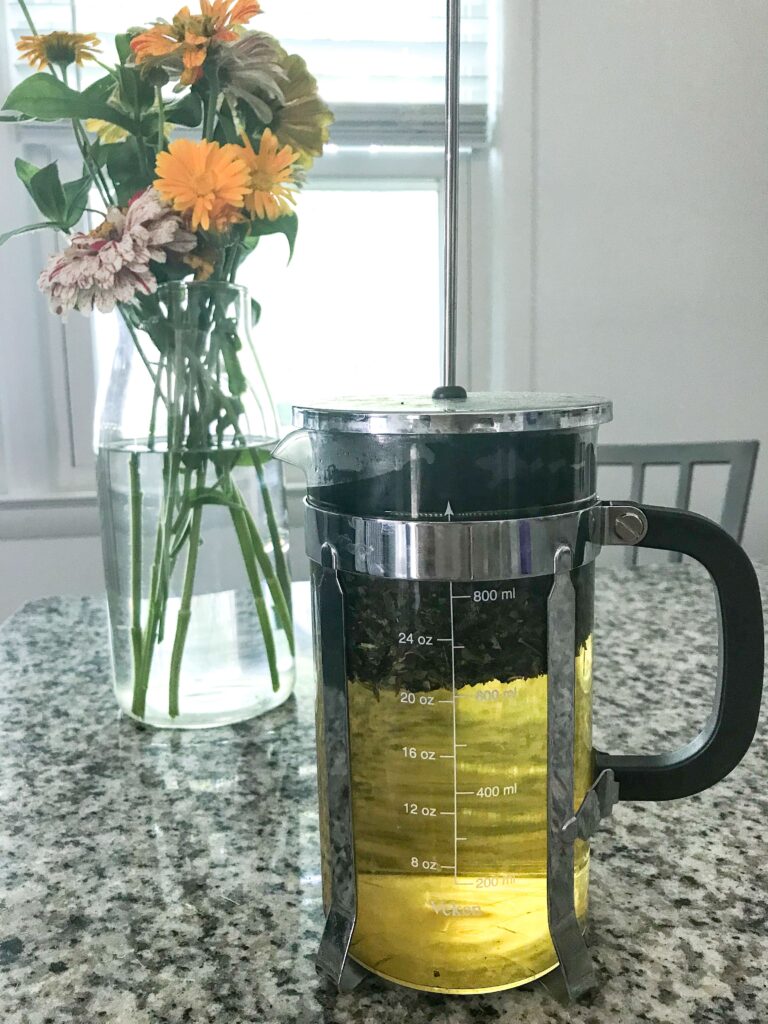
Lately, I’ve been trying to break my afternoon iced coffee habit. I don’t know when it became such a regular thing, but I know two coffees a day is not great for my adrenals or my anxiety-prone nervous system.
Problem is, I always want something that feels like a treat in the mid- to late afternoon, when my motivation is beginning to wane.
I’m certainly not here to shame anyone over their caffeine habit. Goodness knows, I regularly feel like Lorelei in Gilmore Girls Season 1 when she proclaims, “I need coffee in an IV.”

But I am here to proclaim the benefits of drinking herbal tea.
It’s a great entryway to herbal and functional medicine. And drinking your herbs is a fantastic way to support specific health outcomes.
The Anxie-Tea recipe below is part of how I manage my anxiety symptoms without pharmaceuticals. Again, no shame – do what you and your doctor decide is best for you. I’m all for SSRIs and Western medicine if that’s how you feel like your best self. It’s also just a delicious tea regardless of if you’re interested in its medicinal benefits.
Ditto for my Hormone Balancer Tea. It helped me regain my period when I went off birth control a few years ago, and has lots of nourishing herbs for people with uteruses. But it’s a tasty, hydrating treat regardless of your internal organs.
And if you too want to consume less caffeine, my Herbal Energizer on ice has been keeping me going this summer. In fact, each of these herbal tea recipes is nourishing and soothing when drunk hot, but I’m personally not tryna drink a hot beverage between the months of May and September. Each of these is just as excellent – if not more so – iced, and gains additional health benefits by the slow infusion that occurs when you let it steep until cool. I walk you through my specific routine for preparing these herbal tea recipes as infusions so they’re ready when I’m craving iced tea in the afternoon.
Just interested in the recipes? Jump down for recipes for my Herbal Energizer Tea, Anxie-Tea and Hormone Balancer Tea. But if you’re interested in why you should drink herbal tea and the specific benefits of each of these recipes, scroll down for some science!

Why drink tea over coffee?
Let’s start with the reason most of us drink coffee: the caffeine. The average 8 oz. cup of drip coffee has 95 mg of caffeine. Compare that to black tea at 47 mg and Yerba Mate (the only caffeinated herbal tea) at 85 mg per cup. So, depending on the tea you choose, you’re getting anywhere from near-drip coffee levels to no caffeine at all.
If coffee gives you the jitters or makes you anxious, a tea with a lower caffeine level may help. Research has found that our bodies respond differently to the caffeine in tea differently than in coffee. When you drink coffee, your body consumes 99% of the caffeine with 45 minutes – leading to that spike in energy (or anxiety). With tea, the absorption is more gradual, giving a longer, smoother energy boost than coffee.
Teas are also rich in antioxidants and L-theanine, an amino acid with calming properties that may relax you even while keeping you alert.
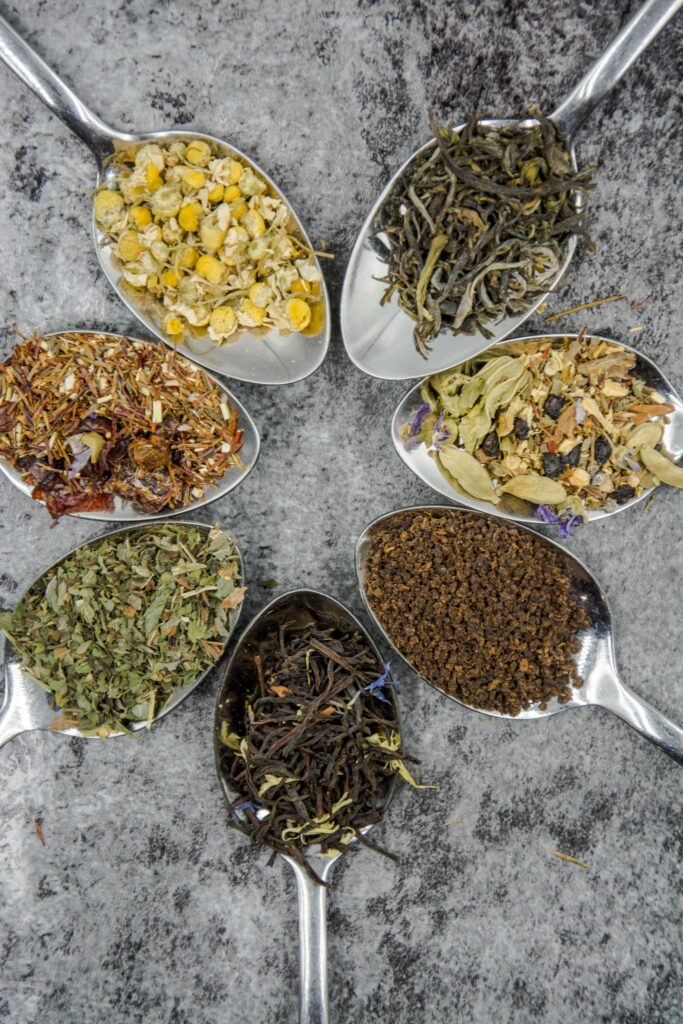
So why herbal tea?
Herbs are simultaneously some of the most ancient and most widely consumed medicines in the world – especially in the form of tea. In fact, the World Health Organization has a specific Traditional Medicine Strategy that promotes the use of herbal medicines for the treatment of chronic diseases.
Herbs are rich in phytochemicals (or, biologically active compounds) that have medicinal benefits for humans. Many herbs are full of antioxidants and antimicrobials, as well as more specific therapeutic benefits.
Hot, liquid-based herbal infusions (i.e. tea) provide the ideal medium for harnessing the therapeutic properties of plants. Water releases water-soluble phytochemicals like phenols and flavonoids. Consuming them this way may be even more effective than just consuming the dried leaves of the herbs.
Hot water facilitates the release of volatile oils from the herbs that then enter the bloodstream via your digestion or nasal passages. In short, not only is tea one of the simplest and quickest ways to take your medicine, it’s also one of the most effective for garnering the therapeutic benefits of herbs.
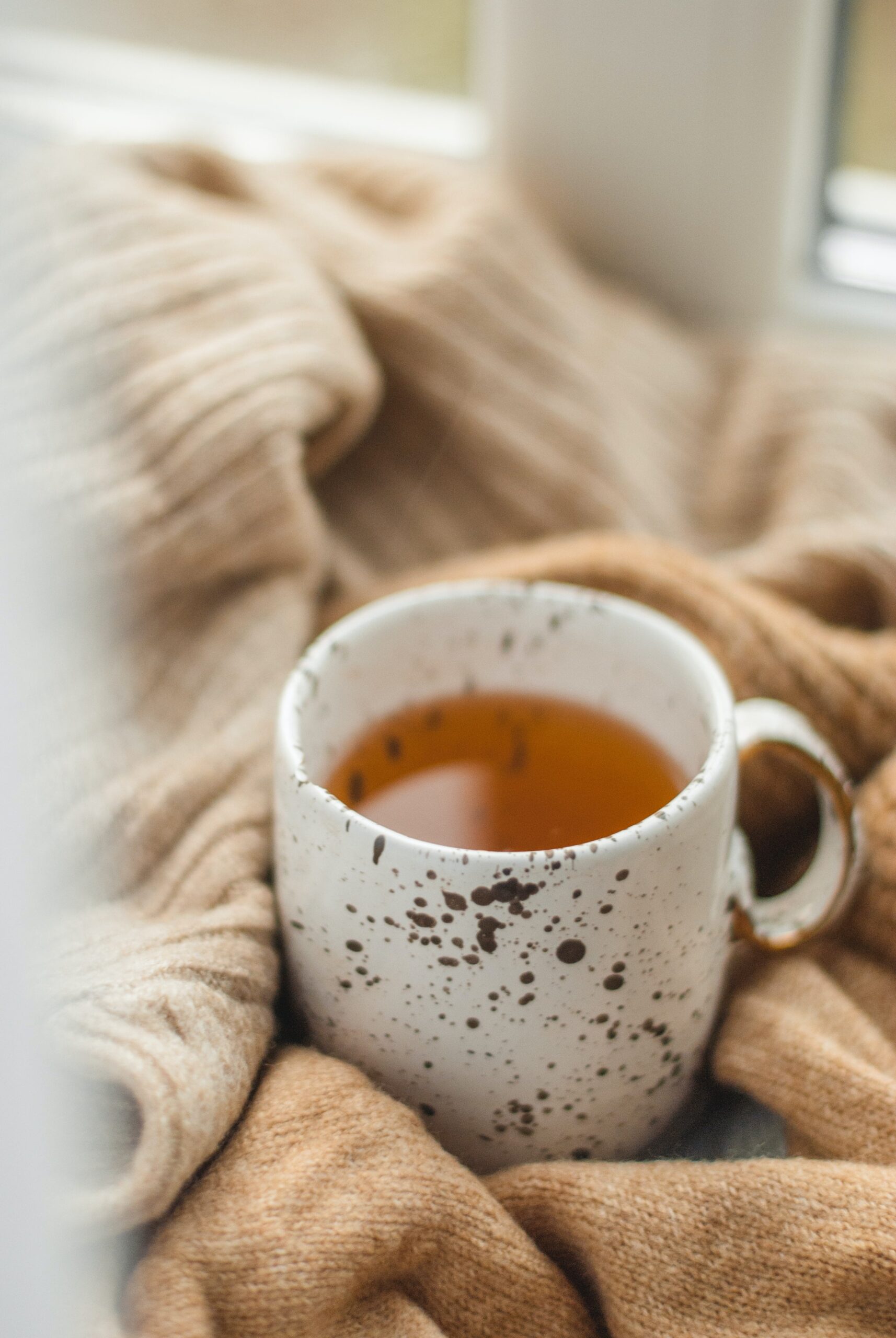
What are the health benefits of herbal tea?
The health benefits of herbal tea vary depending on the herbs in question. I’ve discussed some of the generalities above, but let’s talk about the herbs in these recipes in more detail now.
My Herbal Energizer tea is a 2:2:1 blend of peppermint, stinging nettle, and lemon balm. Here, the peppermint mainly serves to enhance the flavor, but does have numerous health benefits of its own. The nettle provides the energizing effect, while lemon balm supports alertness and brain health.
The recipe for my Anxie-tea is more complex, but the lavender, lemon balm, oatstraw and valerian root are all nervine herbs. This means they support the nervous system – helping you to relax and relieving anxiety symptoms. For me, the valerian root is a really powerhouse herbal ally.
And finally, while I developed my Hormone Balance Tea recipe specifically to help me balance my hormones, it’s good support for anyone with a uterus. Chasteberry, or vitex, supports the pituitary gland and the production of progesterone. Red raspberry leaf relieves painful periods. Stinging nettle battles fatigue while peppermint settles the stomach and soothes headaches. Finally, catnip is a sedative and will help induce menstruation.
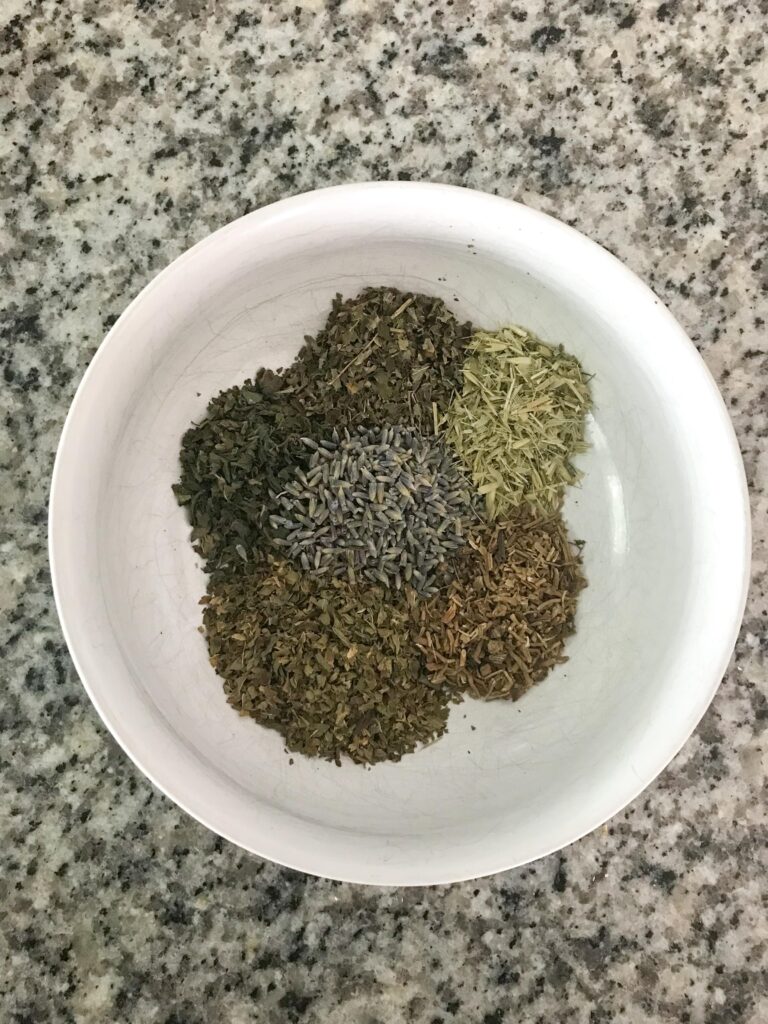
How do I prepare herbal tea?
You can prepare herbal tea much the same as you’d prepare any other cup of tea, bagged or loose leaf. In short, add your leaves to your steeping vessel of choice. This can be a teapot, an infuser, straight into your mug, or – my personal favorite – a French press.
Pour hot water (hot but not boiling – see more in the recipe card below) over tea leaves. Cover your steeping vessel so no steam can escape and let steep at least 15 minutes.
I suggest steeping your tea for much longer than the instructions that come from boxed tea bags do. This is because the longer you steep, the more chance the water has to draw out the medicinal properties in the tea leaves. There’s a world of difference between a tea that was steeped for 5 minutes and an infusion that steeped overnight. This is also why it’s so important to cover your tea while it’s steeping. The oils in the tea that contain the medicinal properties will evaporate with the steam otherwise.
If you’re looking for a hot cup of tea, you’re good to go when your 15 minutes are up. If you’re interested in iced tea, or gaining as much of the health benefits of your tea as you can, prepare an infusion instead.
To prepare an infusion, follow the same process for hot tea, but allow to steep for several hours to overnight. Infusions are great for all herbal teas, but are especially important if your blend contains any woody herb parts like stems or roots. For example, the Anxie-Tea recipe below calls for valerian root. You’ll extract its medicinal properties much more fully via an infusion than a shorter-steeped tea.
My process to ensure I have tea to drink every afternoon:
I prepare and steep my tea before I go to bed each night. I make a full French press, leaving the stopper up and allowing it to sit on the counter overnight. In the morning, I depress the plunger and pop the whole thing in the fridge.
Come afternoon, my tea is nice and chilled so I just pour over ice and enjoy!
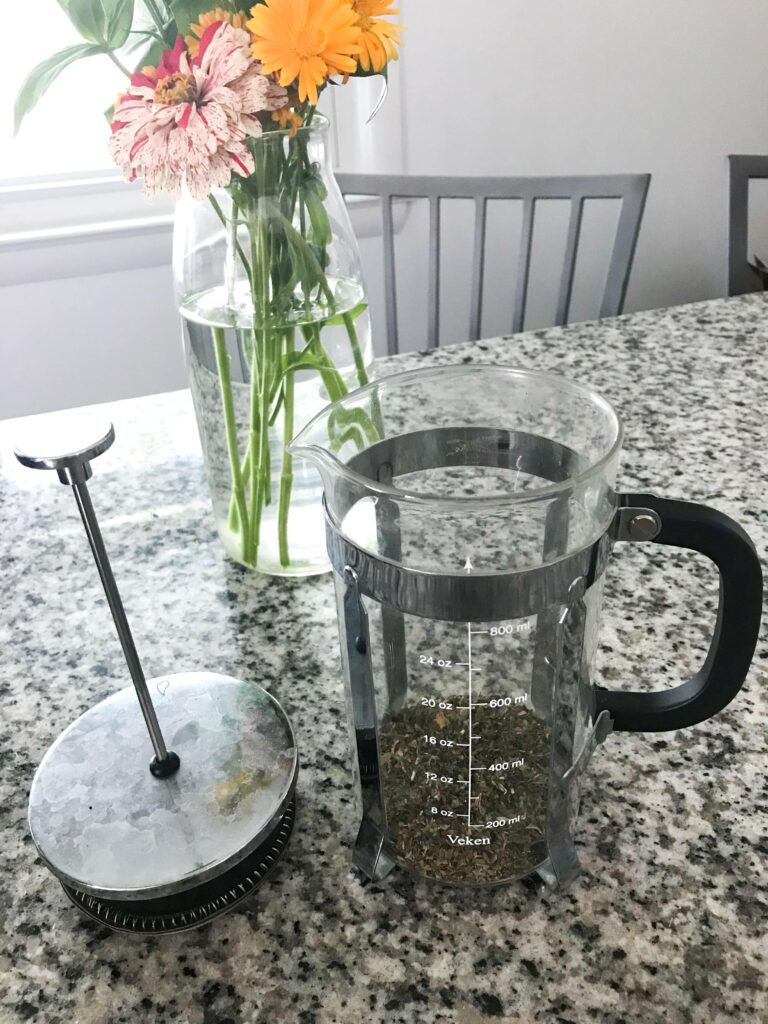
Where do I source herbs to make these herbal tea recipes?
There are many places to source dried herbs – including from your own garden or responsible wildcrafting in your area.
When ordering online, I get mine from Mountain Rose Herbs. You have as many choices as the internet can serve up to you, just make sure you vet quality, sourcing, sustainability, etc.
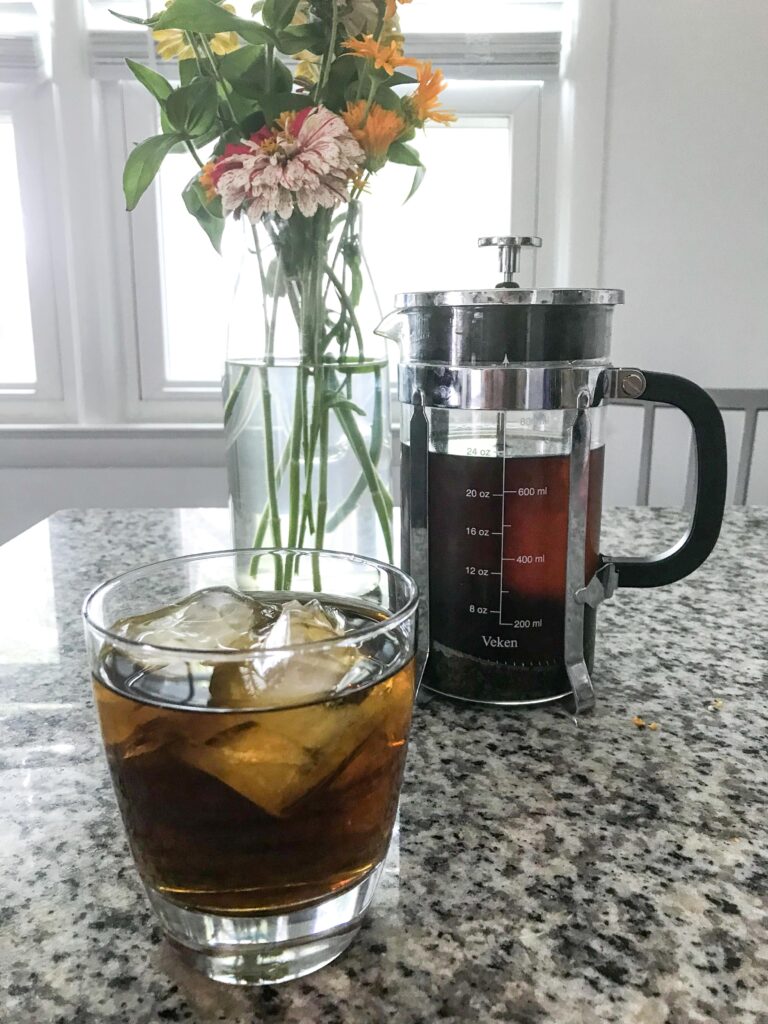
How long will dried herbs last?
All of the recipes below call for dried herbs as these are more shelf-stable and allow you to blend multiple pots worth of tea at once. In fact, I tend to make large batches around the holidays and give them away as gifts.
But ultimately, this comes down to how you store them. Dried herbs, be they medicinal or culinary, can lose potency and quality over time – especially when exposed to heat and light.
Your best bet is to store in a dark, opaque container in a cool, dark, dry place. Under ideal conditions, dry herbs and tea blends should last around 2 years.
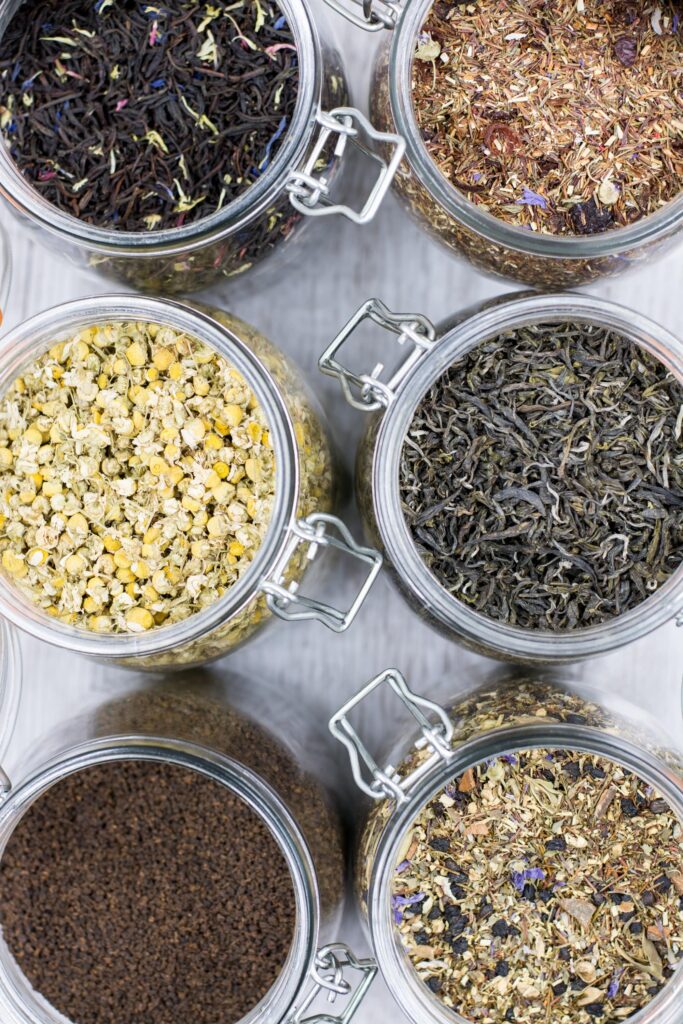
an important disclaimer
Please note that none of the information in this post has been evaluated by the Food and Drug Administration and is not intended to diagnose, treat, cure or prevent any disease. Consult with a qualified healthcare practitioner before using herbal products, particularly if you are pregnant, nursing or on any medications.
I’m super interested in herbal and functional medicine as ways of supporting health, instead of just managing sickness. But I am by no means a qualified herbalist or medical practitioner. This was just a super zoomed out overview based on my research. I encourage you to do your own and to work with a qualified herbalist/alternative medicine practitioner if that interests you. Many herbs work best in formulation, and that’s hard to get right on your own.
If you’re interested in learning more about herbal medicine/wild food, here are the websites/social handles of some good places to get started: Sage Mountain Botanical Sanctuary (founded by Rosemary Gladstar), Chestnut School of Herbal Medicine, the Herbal Academy, Rowan and Sage, and Black Forager.
If you’re new to all of this, starting out by just eating or drinking your herbs is a great entry point! Get to know an herb by making tea with it or incorporating it into your cooking. Food is Medicine. If you’re looking to step a little deeper on this path, try my recipe for a diy chamomile tincture!
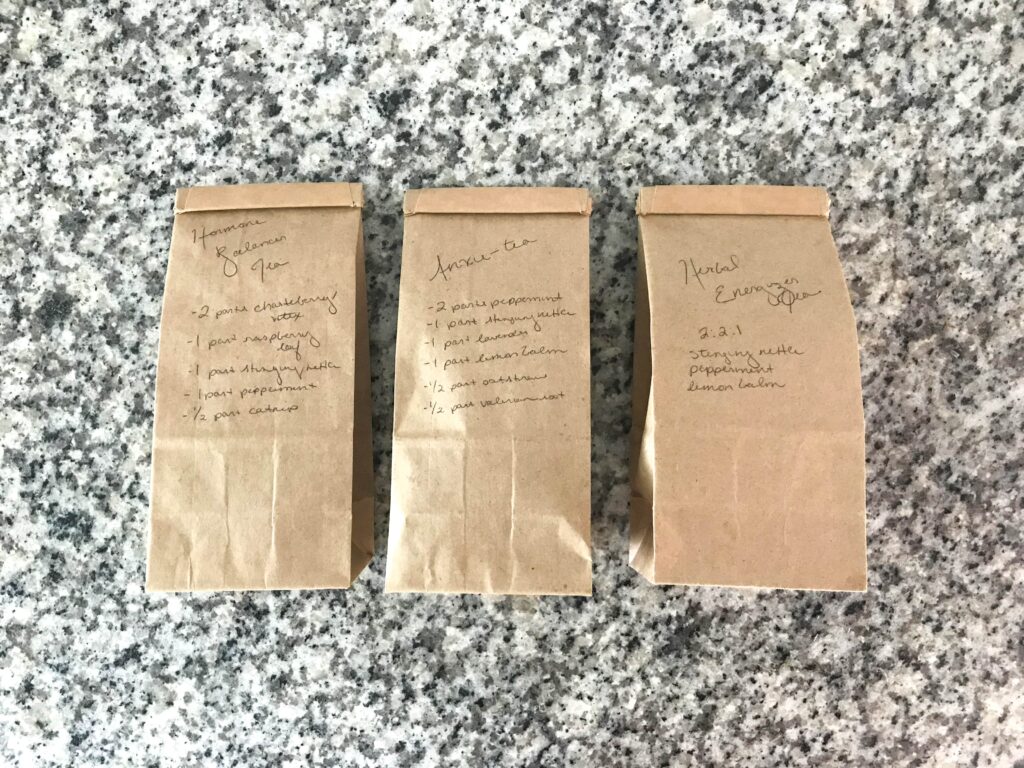
Three Herbal Tea Recipes – delicious hot or iced!
Yes, there’s heavy representation of peppermint, lemon balm, and stinging nettle in these recipes. On a practical note, the peppermint and lemon balm make sure these teas taste good. Meanwhile, the stinging nettle is full of iron and other minerals we tend to be deficient in. And peppermint (and lemon balm, which is in the mint family) is a garden bully so I’m always harvesting and trying to use it. Plus stinging nettle is an easily forageable herb in early spring.
3 Refreshing Herbal Tea Blends (drink hot or iced!)
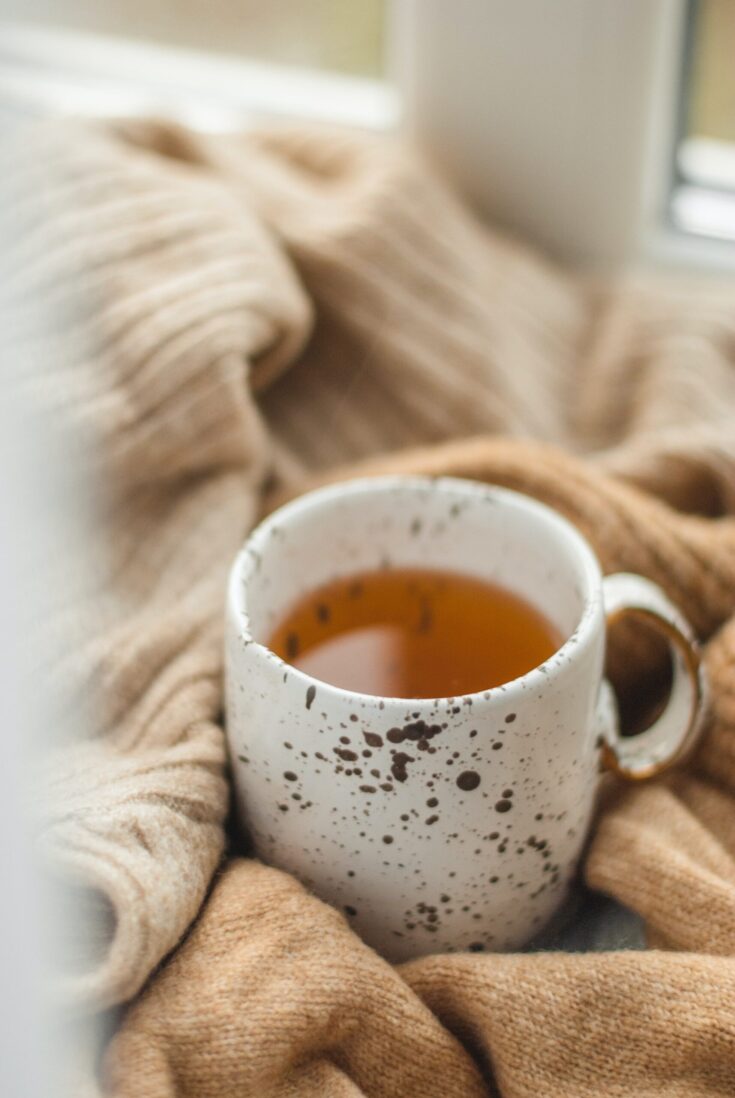
Whether you’re trying to kick a caffeine habit, already a tea devotee or just curious, these three herbal tea recipes are tasty, refreshing and a great way to support health outcomes!
Ingredients
Herbal Energizer Tea
- 2 parts dried stinging nettle leaves
- 2 parts dried peppermint leaves
- 1 part dried lemon balm leaves
Anxie-Tea
- 2 parts dried peppermint leaves
- 1 part dried stinging nettle leaves
- 1 part dried lavender
- 1 part dried lemon balm leaves
- ½ part dried oatstraw
- ½ part dried valerian root
Hormone Balancer Tea
- 2 parts dried chasteberry/vitex
- 1 part dried raspberry leaf
- 1 part dried stinging nettle leaves
- 1 part dried peppermint leaves
- ½ part dried catnip
Instructions
- Combine dried herbs for your chosen blend in a large, dark-colored jar or paper bag and shake to mix. (An opaque container will protect your herbs from being degraded by sunlight.) Store in a cool, dark place.
- To make tea: Boil water in an electric kettle or on the stove.
- While waiting for water to boil, shake your tea container again to ensure herbs are evenly mixed and add tea to your teapot/infuser/drinking vessel. Start with a ratio of 1 tbsp tea leaves to a ½ litre of water, but feel free to adjust to taste.
- When water reaches the desired temperature, pour over your tea leaves and cover to trap steam. Steep for 15 minutes. You never want to pour boiling water over your herbs as it's just too hot and will destroy some of the delicate oils in them. If you can catch it, pour water just before it boils. If, like me, you miss that the water's boiling until it's boiled over onto the stove, let it boil and then turn it off. Let it cool a minute, and then pour over your herbs.
- Alternately, allow to steep overnight for an herbal infusion. Then chill and drink iced.
Notes
- The number of servings here is just a suggestion as this recipe is in parts rather than specific measurements. This allows you to scale up or down depending on how much of the tea blend you want to make. If you're new to working in parts, just substitute the "part" for the measurement of your choice. For example, say I were making my herbal energizer tea and decided that 1 part would be ¼ cup. 2 parts would then be ½ cup. So I would blend ½ cup dried peppermint, ½ cup dried stinging nettle, and ¼ cup dried lemon balm. This would yield ¾ cup, or about 12 servings.
- I suggest steeping your tea for much longer than the instructions that come from boxed tea bags do. This is because the longer you steep, the more chance the water has to draw out the medicinal properties in the tea leaves. There's a world of difference between a tea that was steeped for 5 minutes and an infusion that steeped overnight. This is also why it's so important to cover your tea while it's steeping. The oils in the tea that contain the medicinal properties will evaporate with the steam otherwise.
- If you avoid gluten, please be careful how you source your oatstraw. While the plant itself is gluten-free, it's at high-risk for cross-contamination while processing. Be sure what you purchase has been certified gluten-free.

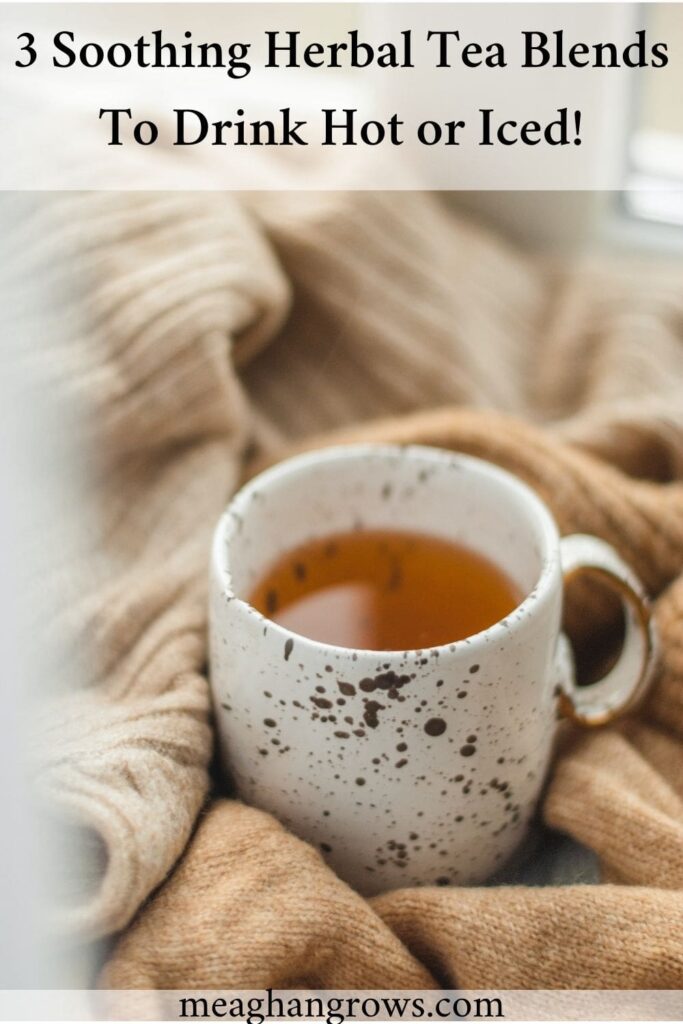


Wow! Wish I could have some of that right now as I am about to board a plane and could use the anti-anxiety effects! I had no idea that my least favorite weed (stinging nettle) in my garden could be so useful. Thank you – this was very informative and I will give your recipes a try.
Herbal teas are my favorite thing to have after dinner. Thanks for all your lovely tips and for sharing such a great post.
Ooh I totally need to try these!! Just need to get a few more herbs in!
I love herbal teas and I am super excited to try your blends. Now I just need to kick the coffee beans out of my French press … 😉
This is a great post! I love herbal teas, I will try your blends of herbs. Thank you for sharing!!
I’m a huge tea fan! Love all the info you’ve included here – you’ve inspired me to order some chasteberry to add to my collection too!